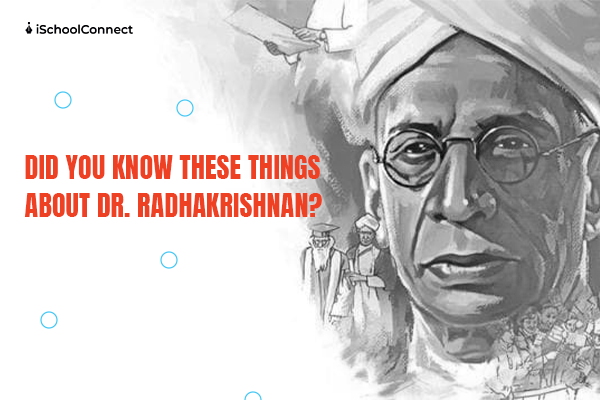Table of Contents
Dr. Sarvepalli Radhakrishnan was no ordinary man. He was one of the most renowned philosophers of his time, an influential spokesperson, India’s first vice president, and the second president of the country. He made immense contributions in the field of education to bring a positive change in the country and uplift people’s lives.
Who was Dr. Sarvepalli Radhakrishnan?
Dr. Sarvepalli Radhakrishnan was born on 5th September 1888 in a Brahmin family in Tamil Nadu, India. His father, Sarvepalli Veeraswami, worked as a subordinate revenue official, and his mother’s name was Sarvepalli Sita. Dr. Radhakrishnan got married at the age of 16. He had five daughters and a son with his wife Sivakamu.
Dr. Sarvepalli Radhakrishnan was not only a great scholar, but he was also a politician and statesman. He served as India’s first vice president and then became the second president of India. Dr. Radhakrishnan was a brilliant writer, his writings could bring a positive change, and he stood as a symbol of Hinduism in the west. He believed in Vedanta and was an absolute idealist. He believed that God resides in each man, irrespective of his or her race or sect. As a writer, he was not against western philosophy and drew references from both western and Indian sources while writing prose.
Dr. Radhakrishnan’s education

In his academic life, he was awarded various scholarships as he was a meritorious student. After his primary and secondary education, he went to Voorhees College in Vellore. At the age of 17, he moved to Madras Christian College. He completed his bachelor’s degree, and in 1906, he completed his master’s degree in Philosophy from the institution. “The Ethics of the Vedanta and its Metaphysical Presuppositions” was Sarvepalli’s paper for his bachelor’s degree thesis. He was highly praised for his dissertation, and the thesis was published when he was only twenty years old.
Career
Dr. Sarvepalli Radhakrishnan was a professor of Philosophy in 1918 and taught at the Maharaja’s College in Mysore. During this time, he began writing several important articles for popular journals, like The Quest, Journal of Philosophy, and the International Journal of Ethics. He also wrote his very first novel in 1918 and became a professor of Philosophy at the University of Calcutta. In June 1926, he represented the university at the British Empire Universities Congress.
One of his significant academic events is the lecture he gave at Manchester College, Oxford, in 1929. It was later published as “An Idealist View of Life” in book form. After India’s independence, he refused to continue using the title given to him as an honor by the Britishers and used his academic title of doctor only. He also served as the vice-chancellor of Andhra University, followed by the position of vice-chancellor of Banaras Hindu University (BHU). Dr. Radhakrishnan was nominated for the Nobel Prize in literature in 1937.
Political journey
Dr. Radhakrishnan had an immensely promising academic career and then set out on a remarkable political career later in his life. He was already an international figure; he attended the Andhra Mahasabha in 1928 and put forward his idea regarding the Ceded districts. Radhakrishnan’s involvement in Indian politics increased to a great extent, and he was at the same time actively involved in foreign affairs in the years following India’s independence. From 1946 to 1951, Dr. Radhakrishnan was a member of the newly formed UNESCO and successfully was a part of the Executive Board, heading the Indian delegation.
For two years, he remained a vital member of the Indian Constituent Assembly, his responsibilities began to increase, and he was soon elected to the Rajya Sabha, where he was able to bring his philosophical and political ideas into motion. In 1952, Radhakrishnan was elected as India’s first vice-president. Soon after serving his tenure, he was elected as the country’s president in 1962. Dr. Radhakrishnan, during his tenure, spoke about world peace and universal fellowship. He had to face political conflicts with China during the early 1960s, followed by hostilities between India and Pakistan. He spread the word regarding tolerance between cultures and nations.
Achievements and recognitions

- Dr. Sarvepalli Radhakrishnan was honored with the highest civilian award in India, the Bharat Ratna Award, in 1954.
- He was also honored by Germany with the Pour le Mérite for Sciences and Arts in 1954.
- He was knighted by King George V for his immense contributions to the field of education in the year 1931.
- He received the Sash First Class of the Order of the Aztec Eagle in 1954 from Mexico.
- He was nominated for the Nobel Prize 27 times, including 16 times for literature and 11 times for the Nobel Peace Prize.
- In 1938, he was elected as a Fellow of the British Academy.
- He was awarded the Peace Prize of the German Book Trade in 1961.
- In 1968, he became the first-ever person to be awarded the coveted Sahitya Akademi fellowship.
- Since 1962, India has annually celebrated Teacher’s Day on 5 September to mark Dr. Radhakrishnan’s birthday. This day is a tribute to the iconic personality, to value his ideas, as well as to celebrate teachers, teaching practices, and their rights.
- In 1975, he received the Templeton Prize for promoting non-violence and conveying the idea of compassion and knowledge for all people.
Literary works by Dr. Radhakrishnan
Dr. Radhakrishnan was a remarkable writer; his first book was Philosophy of Rabindranath Tagore, followed by his second book, which was published in 1923, named Indian Philosophy.
The Hindu View of Life was published in 1926, where he wrote about Hindu philosophy and beliefs. An Idealist View of Life, Kalki or the Future of Civilization, Eastern Religions and Western Thought, Religion and Society, The Bhagavadgita: With an introductory essay, Sanskrit text, English translation, The Dhammapada, The Principal Upanishads, Recovery of Faith, A Source Book in Indian Philosophy, The Brahma Sutra: The Philosophy of Spiritual Life, and Religion, Science & Culture were his notable books.
What’s Next?
We have read about Dr. Radhakrishnan’s early life, education, career, achievements, awards, and literary works in this article. He was a stalwart and an extraordinaire in every sense. He continues to be an inspiration for the youth. As a student, you may get your hands on his biographies and books to gain more knowledge of various subjects and secure a brighter future.
FAQs
Q1. What are some of the qualities Dr. Sarvepalli Radhakrishnan was known for?
Answer – Dr. Sarvepalli Radhakrishnan was a great orator. He was hardworking, caring, humble, and extremely knowledgeable.
Q2. Whose role model should Dr. Sarvepalli Radhakrishnan be?
Answer – Dr. Sarvepalli Radhakrishnan is a role model for all students and teachers. He was a great thinker and always expressed his thoughts with clarity. He encouraged the students and emphasized mental education, moral strength, and moral integrity.
Q3. What was Dr. Radhakrishnan’s outlook on science and technology?
Answer – Dr. Radhakrishnan believed that education could help the youth face different challenges and build the India of dreams. He said scientific and technological studies will develop in us an attitude of tolerance, freedom from prejudice, and hospitality to new ideas.








I really like this. It’s very interesting and knowledgeable